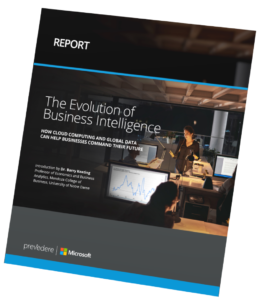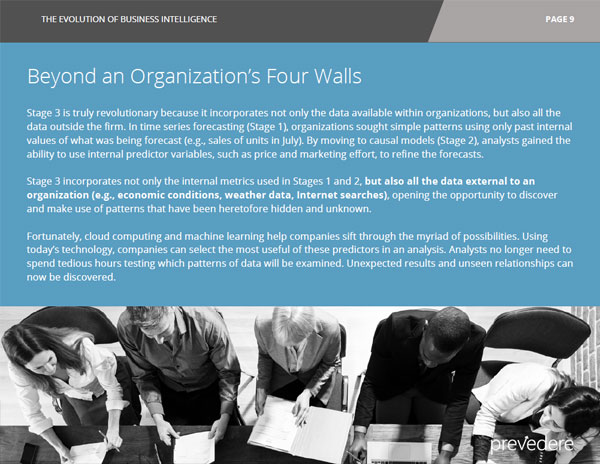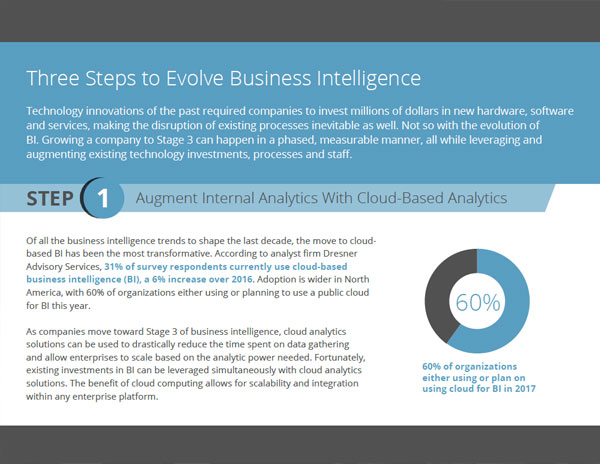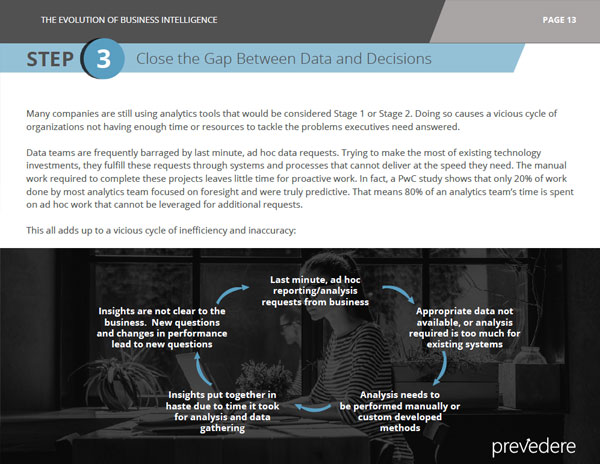Last Updated: June 22, 2018
The evolution of traditional BI is here. Today if you are not merging your use of cloud analytics with BI Insights, your organization is missing out. In late 2017, the Wall Street Journal ran a two-part article series on the battle over Excel. The first, Stop Using Excel, Finance Chiefs Tell Staffs, showcased some enterprises shifting away from the Microsoft staple in favor of robust new tools. It drew such a passionate response, the follow-up Finance Pros Say You’ll Have to Pry Excel Out of Their Cold, Dead Hands detailed stark loyalty to Excel.
Both arguments miss a key point in the debate, however. With today’s cloud computing power, it does not matter which tools companies use for BI. It matters how they augment those selected tools with better data and analysis capabilities to deliver forward-looking insights with more accuracy and efficiency.

In a recent report, The Evolution of Business Intelligence, Prevedere, Microsoft and Dr. Barry Keating of the University of Notre Dame explored how improving BI processes no longer requires investing millions of dollars in new hardware, software, and services. Instead, adapting BI to become truly predictive can happen in a phased, measurable manner, all while leveraging and augmenting existing technology investments, processes, and staff.
Here are three ways leading enterprises are doing just that:
1) Cloud-Based Analytics Augment Internal Analytics
The move to the cloud solves several challenges as old as the business intelligence field itself. Namely, the time spent gathering, cleaning and formatting data. In fact, approximately 80% of a data scientist’s time is spent on data preparation. That leaves only eight hours per week free for analysis, interpretation, and insights. With the ability to analyze unstructured data and update data sets in real time, cloud analytics inverts this time discrepancy, freeing data scientists to focus on insights by organizing and processing a previously unimaginable amount of data. Read more here>>
2) Adding Power to Existing BI Tools with External Data
Understanding internal historical performance is important, but reliance on this information alone does not provide a holistic view of what truly drives businesses. When cloud-based analytics are used to perform the significant task of gathering and analyzing external datasets, companies gain more accurate insights into where their businesses are heading. Today’s cloud-based tools can identify the best external data to use, augmenting existing tools and processes with this information so that data scientists can spend more time refining, testing and delivering timely insights. Read more here>>
3) Leveraging Machine Learning to Improve Forward-Looking Business Intelligence
 Data teams are frequently barraged by last minute, ad hoc data requests. Trying to make the most of existing technology investments, they fulfill these requests through systems and processes that cannot deliver at the speed they need. The manual work required to complete these projects leaves little time for proactive work. In fact, a PwC study shows that only 20% of work done by most analytics team focused on foresight and were truly predictive. That means 80% of an analytics team’s time is spent on ad hoc work that cannot be leveraged for additional requests.
Data teams are frequently barraged by last minute, ad hoc data requests. Trying to make the most of existing technology investments, they fulfill these requests through systems and processes that cannot deliver at the speed they need. The manual work required to complete these projects leaves little time for proactive work. In fact, a PwC study shows that only 20% of work done by most analytics team focused on foresight and were truly predictive. That means 80% of an analytics team’s time is spent on ad hoc work that cannot be leveraged for additional requests.
By mimicking the methodology of industry experts, data scientists or economists, machine learning empowers companies to efficiently and accurately determine the best data for their industries, for the time frame and the business decision needed. It facilitates the mining and analysis of hundreds of internal and external business drivers, which is key to drive faster, make smarter decisions and gain a competitive edge.
While some financial teams may rejoice and others will sigh, there is no need to completely replace Excel or other BI tools to achieve more accurate predictive forecasts. Smart companies are enhancing – not eliminating – traditional tools with cloud-based, external data-driven intelligence gleaned from machine learning.


